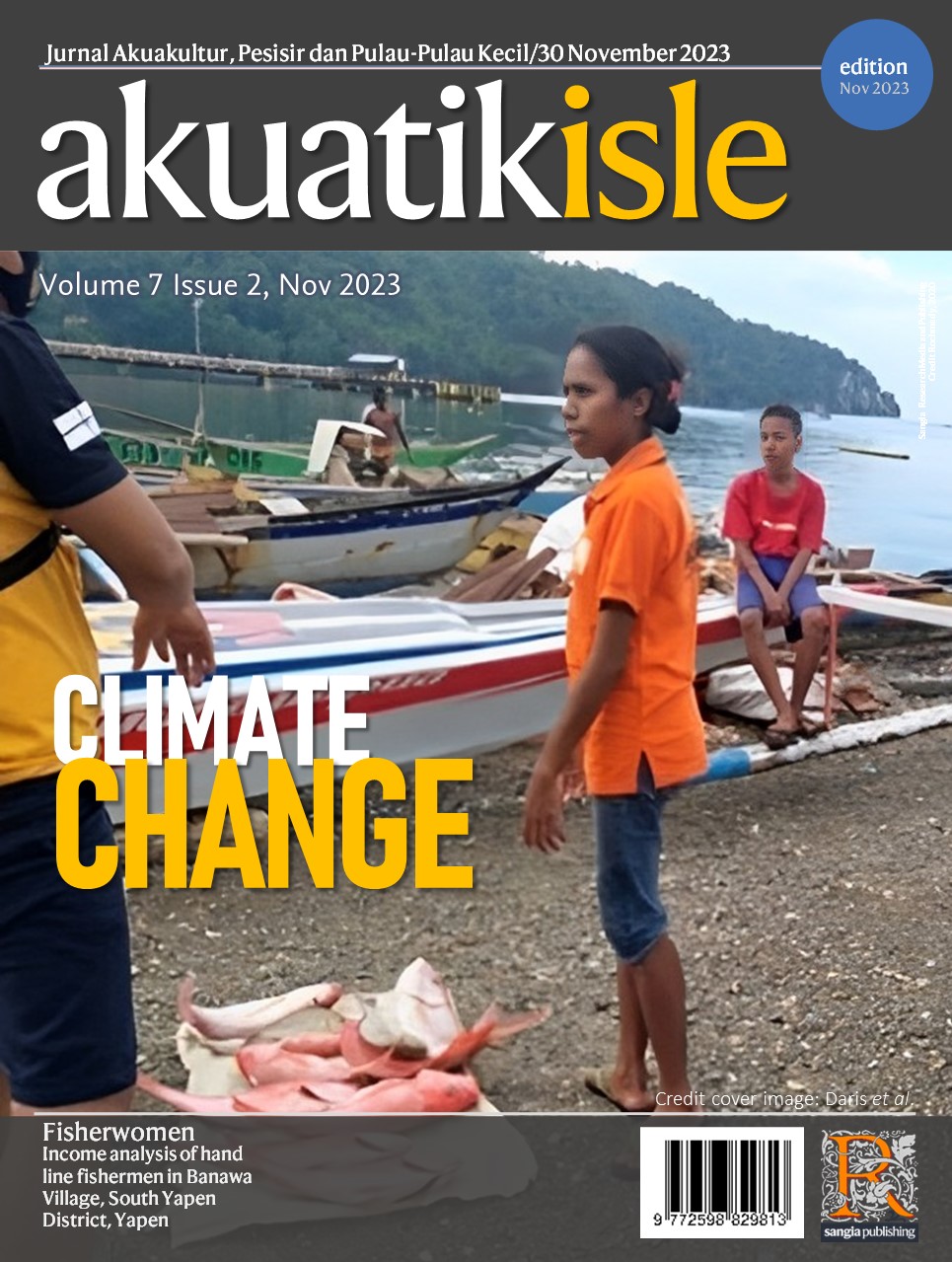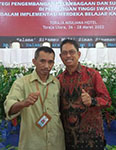Akuatikisle: Jurnal Akuakultur, Pesisir dan Pulau-Pulau Kecil
Full Length Article
The enlargement of painted spiny lobster (Panulirus versicolor) uses different feed ingredients
Highlights
Generate NLP AI by Wizdam ID.
Abstract
Development of lobster cultivation activities in Muna regency relatively not optimal. Availability of feed is be expected to be an obstacle in the development of lobster cultivation. This Research aims to determine the effect of feed ingredients on growth and survival of spiny lobster (Panulirus versicolor). The Research was conducted in December 2017 to March 2018, located in Bahari Village, Towea District, Muna Regency, Southeast Sulawesi Province using a randomized block design with three levels of feed ingredients treatment namely treatment A = blood clam meat, treatment B = white shrimp and treatment C = trash fish. The results showed that the highest specific growth rate was obtained in treatment A which was 1.69 ± 0.09 %/day, then treatment C (1.13±0.09 %/day), and the in lowest treatment B (1.09±0,06 %/day). The highest absolute growth was obtained in treatment A of 606.67 ± 15,28 g/individual then treatment C was 336.67±15,28 g/individual and the lowest was in treatment B of 300.00±10.00 g/individual. Survival of sea lobster is 100% in all three treatments. Analysis of variance at the 95% confidence level (α0.05) showed that different feed ingredients had a significantly different effect on the daily growth rate, and the absolute growth of sea lobsters (P. versicolor).
Keywords
Introduction
Section snippets
Material and Methods
Materials and methods from the full-text PDF of this article cannot be displayed.
Results
Results from the full-text PDF of this article cannot be displayed.
Discussion
Discussion from the full-text PDF of this article cannot be displayed.
Conclusions
Conclusions from the full-text PDF of this article cannot be displayed.
Acknowledgment
Acknowledgment from the full-text PDF of this article cannot be displayed.
Competing interest
The authors declare that they have no known competing financial interests or personal relationships that could have appeared to influence the work reported in this paper.
Conflict of interest
The authors declare that the research was conducted in the absence of any commercial or financial relationships that could be construed as a potential conflict of interest.
Ethical approval acknowledgements
No ethical approval required for this article. All procedures followed were in accordance with the ethical standards of the responsible committee on human experimentation (institutional and national) and with the Helsinki Declaration of 1975, as revised in 2008 (5)
Supplementary files
Data sharing not applicable to this article as no datasets were generated or analysed during the current study, and/or contains supplementary material, which is available to authorized users.
References (1)
Adiyana K., Supriyono E., Junior M. Z. & Thesiana L., 2014. Aplikasi teknologi shelter terhadap respon stress dan kelangsungan hidup pada pendederan lobster pasir Panulirus homarus. Jurnal Kelautan Nasional, 9(1): 1–9.
Afrianto E. & Liviawaty E., 2005. Pakan Ikan dan Perkembangannya. Kanisius. Yogyakarta.
Arief M., Fitriani N. & Subekti S., 2014. Pengaruh Pemberian Probiotik Berbeda pada Pakan Komersial terhadap Pertumbuhan dan Efisiensi Pakan Ikan Lele Sangkuriang (Clarias sp.). Jurnal Ilmiah Perikanan dan Kelautan, 6(1): 49–54.
Effendie M. I., 1997. Biologi Perikanan. Yayasan Pustaka Nusatama. Yogyakarta, 163 p.
Hatlen B., Grisdale-Helland B. & Helland S. J., 2005. Growth, feed utilization and body composition in two size groups of Atlantic halibut (Hippoglossus hippoglossus) fed diets differing in protein and carbohydrate content. Aquaculture, 249(1-4): 401–408.
Hilal K. & Fachri Y., 2016. Kepentingan Indonesia melarang ekspor benih lobster ke Vietnam Tahun 2015. Jurnal Online Mahasiswa Fakultas Ilmu Sosial dan Ilmu Politik Universitas Riau, 3(2): 1–15.
Junaidi M., Cokrowati N. & Abidin Z., 2010. Aspek Reproduksi Lobster (Panulirus sp.) di Perairan Teluk Ekas Pulau Lombok. Jurnal Kelautan: Indonesian Journal of Marine Science and Technology, 3(1): 29–35.
Kadafi M., Widaningroem R. & Soeparno S., 2006. Aspek Biologi dan Potensi Lestari Sumberdaya Lobster (Panulirus spp.) di Perairan Pantai Kecamatan Ayah Kabupaten Kebumen. Jurnal Perikanan Universitas Gadjah Mada, 8(1): 108–117.
Kemp J. O. G. & Britz P. J., 2008. The effect of temperature on the growth, survival and food consumption of the east coast rock lobster Panulirus homarus rubellus. Aquaculture, 280(1-4): 227–231.
Mills D. & Crear B., 2004. Developing a cost-effective puerulus collector for the southern rock lobster (Jasus edwardsii) aquaculture industry. Aquacultural Engineering, 31(1-2): 1–15.
Setyono D. E. D., 2006. Budidaya pembesaran udang karang (Panulirus spp.). Jurnal Oseana, 31(4): 39–48.
Yudha S., Wardiyanto & Santoso L., 2014. Efektifitas Pemberian Tepung Usus Ayam Terhadap Pertumbuhan Lele Sangkuriang (Clarias gariepinus). e-Jurnal Rekayasa dan Teknologi Budidaya Perairan, 3(1): 351–358.
Zainuddin M., Djawad M. I. & Ardiyanti R., 2012. Pengaruh level protein pakan terhadap laju metabolisme juwana ikan bandeng (Chanos chanos, Forsskal 1775). Jurnal Iktiologi Indonesia, 12(2): 111–119.
Zonneveld N., Huisman E. A. & Boon J. H., 1991. Prinsip-Prinsip Budidaya Ikan. PT Gramedia Pustaka Utama. Jakarta.
Bibliographic Information
Cite this article as:
-
Submitted
8 August 2023 -
Accepted
24 August 2023 -
Published
31 August 2023 -
Version of record
17 September 2023 -
Issue date
30 November 2023
-
Academic subject
Aquaculture; Biological Science
Keywords
Copyright
Sangia Advertisement
Copyright © 2023 Anshar, Abdul Rakhfid, Mosriula, Samsibar, Karyawati, Ali Sabara. Sangia Research Media and Publishing. Production and hosting by Sangia (SRM™).  This work is licensed under a Creative Commons Attribution-ShareAlike 4.0 International License.
This work is licensed under a Creative Commons Attribution-ShareAlike 4.0 International License.
Disclaimer: All claims expressed in this article are solely those of the authors and do not necessarily represent those of their affiliated organizations, or those of the publisher, the editors and the reviewers. Any product that may be evaluated in this article or claim that may be made by its manufacturer is not guaranteed or endorsed by the publisher.
Comments on this article
By submitting a comment you agree to abide by our Terms and Community Guidelines. If you find something abusive or that does not comply with our terms or guidelines please flag it as inappropriate.










